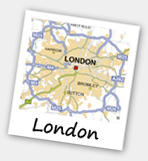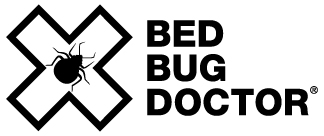|
|
 |
|
|
Life
Cycle:
Bed bugs are insects and
accordingly have the classic
6 legged arrangement. They
are from the order of
species called Hemiptera,
which is often called the
“true bugs” and includes
such insects as the aphid.
The defining feature of
hemipterans is their
possession of mouthparts
where the mandibles and
maxillae are sheathed within
a modified labium to form a
"beak" or "rostrum". This
protruding mouthpart is
called the “proboscis” and
is capable of piercing
tissues (usually plant
tissues but in this case
skin tissues) then sucking
out the liquids (typically
sap but in this case blood).
Zoologically they belong to
the family Cimicidae and as
with all members of the
Cimicidea family, they feed
exclusively on blood. In the
case of the bed bug, it
requires a meal from a
vertebrae host to allow
development between life
stages (called “instars”)
and to reproduce.
Development time from
conception to full adult is
highly influenced by
temperature and passes
through 6 distinct stages of
life to get from egg to
adult. Key information
gleamed from studying the
lifecycle of these organisms
has lead to various options
in methodologies that are
available for controlling
infestations of bed bugs
both with and without
chemicals. Firstly is the
fact that below 13°C all
development stops, females
stop laying eggs and any
laid eggs do not hatch.
Then, at the other end of
the temperature spectrum,
above 36°C we see a
reduction is reproductive
activity and an increase in
the death rate.
Interestingly with prolonged
exposure above 36°C we see a
100% mortality rate for both
eggs and bed bugs at all
stages of life (this is also
true with pro-longed
exposure to extreme cold).
The cause of this phenomenon
is due to a process called
“denaturisation” of
proteins. Bed bugs contain
symbiotic bacteria that are
essential for the production
of micronutrients (that are
needed to keep the bedbugs
alive), by damaging these
symbiotic bacteria using
heat to deform their protein
structures, we are able to
control and kill bed bugs
without the use of
chemicals. In between these
two temperature extremes we
have the optimum temperature
of 25°C that will give the
fastest possible hatching
time of 4 days and a
lifecycle of 36 days. At
this temperature, a lone
female can lay up to 25 eggs
a weeks and up to 500 eggs
can be laid in one lifetime.
From this, it is easy to see
why our modern indoor
environment lends itself so
well to the infestation and
spread of bed bugs.
All our technicians are
experienced and fully
trained pest control
technicians who are able to
identify a bed bug and have
the confidence to train
others (e.g. hotel staff) in
the identification of bed
bugs and the signs
associated with an
infestation of bedbugs.
Technically, only the
presence of actual living
bed bugs is absolute 100%
proof that an active
infestation is present. But
luckily, due to the fact
that bed bugs do not have a
larval stage (i.e. they grow
from a small fully formed
bed bug into a larger
version with exactly the
same body structure and
features) they look exactly
the same at each stage of
life. This makes it easier
than some other pests for a
novice to identify before a
qualified technician is able
to attend a property for
absolute verification and to
deal with the problem. |
|
 |
|
|
 |
|
|
Bed bug eggs:
Bed bug eggs are very small
and measure less than 2mm in
length, they are
distinguishable from other
household insect’s eggs by
simply using a magnifying
glass to inspect them. Each
egg is pearlescent in colour
and has an “end cap” that
abruptly interrupts the
overall smooth curved form
of the egg’s outer shell.
During the later stages of
development, you can clearly
see a distinctive “red eye
spot” of the developing
embryo through the shell of
the egg. Once hatched, the
eggs are recognisable by
their absence of an end-cap
and their translucent hollow
shell containing no red eye
spot. |
|
 |
|
|
 |
|
|
Bed bug cast skins:
With each meal of blood that
the bed bug feeds upon, it
prepares itself for a
“moulting stage” that will
grow the bedbug to its next
stage in life. And a cast
skin is produced as a
by-product. As with the body
structure of a live (or even
dead) bed bug can give us a
positive identification of
this species, so can the
cast skins produced at each
stage of its life. The cast
skins are shed at each stage
of moulting and give us an
almost perfect cast of the
bed bug showing the entire
body structure in perfect
detail. However, a word of
caution regarding the use of
cast skin to identify an
infestation of bed bugs, you
can 100% identify that a
cast skin is that of a bed
bug BUT this is not in
itself proof of a current
ongoing infestation. You
will be unable to
differentiate between a past
or presently active
infestation using cast skin
alone. |
|
 |
|
|
 |
|
|
Bed bug faecal spots:
Often one of the first
indicators of an infestation
of bed bugs, faecal spotting
is an obvious sign to look
out for. This is quite
simply a stain caused by the
digestion and passing of
food. Due to the fact that
bed bugs feed on blood,
these secretions of waste
have a characteristic black
ink-like spot appearance
often present on sheets,
mattresses and bed frames.
These faecal spots can range
in colour, shape and size
depending on various
factors. Firstly, the colour
can range from dark black to
a lighter brown colour
depending upon the
proportion of digested blood
to uric acid. Secondly, the
shape and size of these
spots is very much dependent
on the surface they are
excreted upon. You will
notice that faecal matter
secreted on more absorbent
surfaces such a bed sheet
will be wicked into the
fibres of the sheet and
cause a more spread out and
flat appearance similar to
how you would expect a drop
of ink from a fountain pen
would be absorbed into a
sheet creating a slightly
spread out but flat stain on
a sheet. Faecal matter
deposited on a non-porous
material such as a varnished
wood bed frame or metal bed
frame will have the
appearance of a noticeable
dark raised lump, usually
circular or oval in shape if
they have been allowed to
dry with no smudging. In
between these two extremes
of absorbency, perhaps one
of the most common faecal
effects is that of an
unvarnished wood (very
common in bed frame joints).
In these instances, the
semi-porous properties of
the wood, coupled with the
grained property of wood
structure, causes these
faecal secretions to be
almost half wicked along the
grain of the wood causing a
compact but noticeably
smeared flat and very dark
stain that runs in the
direction of the wood grain. |
|
 |
|
|
 |
|
|
Bed bug bites:
Bed bugs feed on the blood
of humans and require the
availability of exposed skin
to make their feed. Bed bugs
prefer not to climb on their
host to feed and this
behaviour leads us to
explain one of the defining
characteristics of bed bug
bites, the fact that they
are most often found in
collections of three bites
in close proximity (normally
in a neat row). Often these
three bites are
affectionately referred to
in the pest control trade as
“breakfast, lunch and
dinner” and occur in these
distinctive rows as a result
of the bed bug moving along
the edge of an area of
exposed skin to acquire its
full feed. Bed bug bites
differ from that of the ever
popular and often
misdiagnosed flea bites not
only by their lack of
arrangement into neat
clusters but also because
the very centre of a bed bug
bite will tend to display a
more lightly coloured
appearance than the
characteristic deep red
appearance of the flea bite.
However, constant scratching
and agitation of a bed bug
bite can cause a red
appearance that could cause
confusion in a diagnosis.
Reactions to bed bug bites
differ considerably between
different people, it is a
very mild allergic reaction
to an anticoagulant
contained within the saliva
of the bed bug that causes
the characteristic lumps and
bumps we often see. To
explain this, firstly we
have to understand how the
bed bug feeds. By piercing
the skin of a human, the bed
bug has access to blood, but
then it needs a good flow to
blood to get a full feed.
Because of the highly
viscous properties of blood
and the clotting mechanism,
an anticoagulant is required
to thin the blood and stifle
the clotting mechanism
allowing a good,
uninterrupted flow of blood
into the bed bug. The
anticoagulant is secreted by
what is essentially the
equivalent of the bed bugs
saliva and this creates the
perfect flow required for
feeding efficiently. Rather
like mosquito bites, humans
have different allergic
reactions to this saliva and
this can range from no
reaction at all to strong
blistering reactions. Even
cases of anaphylactic-like
shock have been reported but
fortunately this is
extremely rare and 90% of
the time you will just see a
small raised bump similar to
that of a standard mosquito
bite. Bites tend to appear
visually within 12 hours of
being bitten but experiments
have proven that on
extremely rare occasions,
bites can take up to two
weeks to appear, and it has
been noted that this is most
prevalent when being bitten
for the very first time. Any
delay in the visual
manifestation of a bite can
cause issues with
establishing exactly where
and when the bites occurred
and accordingly this can
delay treatment or cause
potential errors in the
diagnosis of an infestation.
Bed bugs usually feed at
night but can adapt if
required to do so. In
instances where a host is
only accessible during
daylight hours, bed bugs
will adapt and start feeding
during the day. This is
especially the case when
chairs and sofas become
infested and this trend
continues into scenarios
such as public transport. |
|
 |
|
|
 |
|
|
Blood droplets and
smears:
Another common indicator of
the presence of bed bugs is
the appearance of “blood
smears” on sheets. You may
notice dark reddish brown
(almost burgundy) tear drop
shaped smears on a sheet,
these are indicators of bed
bug activity. The cause of
these sports is down to over
feeding and subsequent
slight regurgitation of host
blood in a pre-digested
form. Essentially it is just
a drop of blood that has
been smeared on a sheet, and
as such has exactly the
appearance you would expect
from a drop of blood on a
sheet, the blood will turn
from a bright red to a
darker reddish brown colour
over a very short period of
time as it oxidises and
coagulates. The shape of the
drop will flatten and spread
as it is wicked into the
fibres of the fabric, and as
the bed bug moves it will
give the drop a significant
spread into one particular
direction, causing a
characteristic elongated
tear drop shape. |
|
 |
|
|
|
|
|
|
|
 |
|
|
Booking your
appointment:
 Eradicate
your bed bug problem
today by using one of
our fully trained and
experienced bed bug
technicians. Simply call
us now and speak to a
member of our bookings
team on our 24 hour
booking line:
0207 112 8366
or just send us an
email at
bookings@bedbugdoctor.co.uk.
All our technicians have
unmarked vans and
unbranded uniforms so
you can be assured of a
very discreet service. Eradicate
your bed bug problem
today by using one of
our fully trained and
experienced bed bug
technicians. Simply call
us now and speak to a
member of our bookings
team on our 24 hour
booking line:
0207 112 8366
or just send us an
email at
bookings@bedbugdoctor.co.uk.
All our technicians have
unmarked vans and
unbranded uniforms so
you can be assured of a
very discreet service.
For more in depth info,
please visit our
bedbug treatment &
extermination page.
|
|
|
|
|
|
|
|
|
|
|
|
|
|
|
|
|
|
|
|
|
|
|
|
 |
|
|
|
 |
|
|
Areas covered:
 As
speed is of the essence
when dealing with bed
bugs, we aim to start
your treatment as soon
as possible (depending
upon existing bookings).
We have teams of
professionals ready to
deploy within the London
and M25 area, all fully
trained and experienced. As
speed is of the essence
when dealing with bed
bugs, we aim to start
your treatment as soon
as possible (depending
upon existing bookings).
We have teams of
professionals ready to
deploy within the London
and M25 area, all fully
trained and experienced.
|
|
|
|
|
|
|
|
|
|
|
|
|
|
|
|
|
|
|
|
|
|
|
|
 |
|
|
|
 |
|
|
Corporate rates:
 Bed
Bug Doctor Ltd specialise in the extermination,
detection and preventative treatment of bed bugs for
hotels, youth hostels, shops and care homes. To get
a quote and arrange an on-site visit, please contact
us on
0207 112 8366
or just send us an email
at
bookings@bedbugdoctor.co.uk Bed
Bug Doctor Ltd specialise in the extermination,
detection and preventative treatment of bed bugs for
hotels, youth hostels, shops and care homes. To get
a quote and arrange an on-site visit, please contact
us on
0207 112 8366
or just send us an email
at
bookings@bedbugdoctor.co.uk
**
Landlords and letting agents get special pricing
too, get in touch and find out what we can do for
you today. |
|
|
|
|
|
|
|
|
|
|
|
|
|
|
|
|
|
|
|
|
|
|
|
 |
| |
|
 |
|
|
Contact details:
Bed Bug Doctor Ltd.
180-186 Kings Cross Rd,
London,
England,
WC1X 9DE.
0207 112 8366
info@bedbugdoctor.co.uk
Company No: 07639483 |
|
|
|
|
|
|
|
|
|
|
|
|
|
|
|
|
|
|
|
|
|
|
 |
| |
|
 |
|
|
Bed Bug news:
|
|
|
 |
|
|
|
© Bed Bug Doctor Ltd
London 2014 |
|

